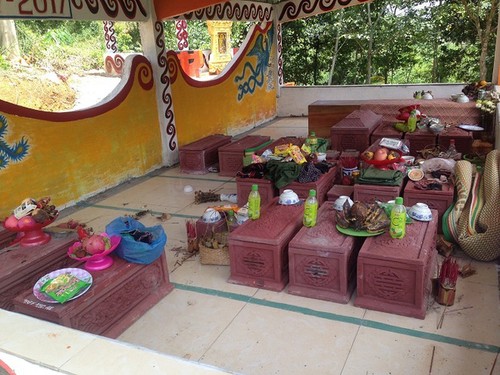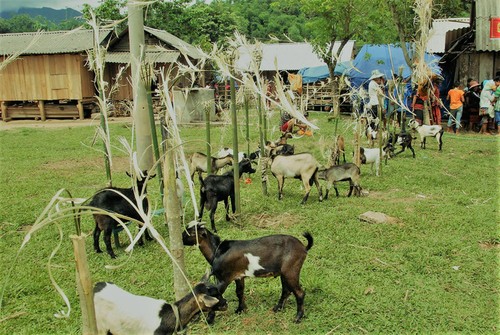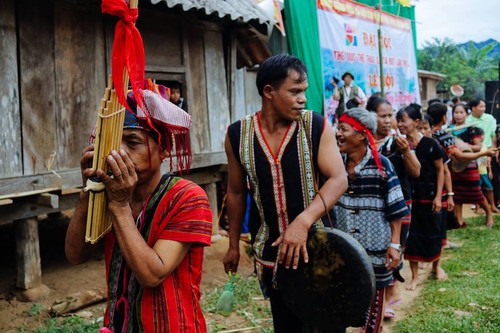The Arieu Ping is the biggest celebration of the Pa Ko, showing the respect and piety of the living for the deceased. At the festival, all families rebuild the tombs of their ancestors, according to village elder Con Penh.
"There is no specific date for an Arieu Ping celebration. It’s organized every 5 to 10 years, depending on the economic condition of the village, but not more than 15 years. We call on all families to hold the celebration where we rebury the remains and repair the tombs. We also invite neighboring villages to join in the festival because we are very close to each other," said Con Penh.
 The Arieu Ping festival which is held every 5 to 10 years involves the whole Pa Ko community. (Photo: dantri) The Arieu Ping festival which is held every 5 to 10 years involves the whole Pa Ko community. (Photo: dantri) |
The Arieu Ping celebration is held to pray for peace and sublimity for the deceased and the stability and health of the living. All villagers are involved in festival activities. Days ahead of the festival, the strongest male villagers make funerary containers to keep the remains. The containers vary in size and can be made of bamboo or wood, said villager Ho Van Lo.
"We don’t burn the dead bodies, we bury them. These funerary containers are used to keep all or parts of the remains. Then we will perform a traditional ritual to pray for sublimity of the deceased after which we deposit the containers into a new and better tomb," Lo explained.
Female villagers go to the forest to collect leaves to make traditional cakes, usually offered to the ancestors and guests during the celebration.
"The leaves easily wilt under the sun so we have to depart in the early morning to pick the youngest and freshest leaves. These leaves are wrapped around sticky rice. Once boiled, they create a unique flavor and one of the Pa Ko’s specialties," said Ho Thi Hoa.
|
 Remains of the deceased, after being exhumed, are kept in the charnel houses. (Photo: nld.com) Remains of the deceased, after being exhumed, are kept in the charnel houses. (Photo: nld.com)
|
The next step is building charnel houses, usually on a large area near rivers or streams. The Pa Ko believe that the water flow all year round will bring luck and peace to the deceased in the afterlife. The bodies of the dead are kept in these houses, regardless of their gender or social status. The biggest house stores the bodies of people who died of sickness while the smaller one keeps the bodies of those who died in accidents. Locals used to decorate the houses with images of naked men and women carved in wood which represents happiness.
The carved wooden blocks have now been replaced with pictures as Hồ Xuân Văn explained: "The host villagers build the house while the guests draw the pictures. Here are women and men’s faces which represent our parents and grandparents. Also there is a very special kind of medicinal herb of the Pa Ko which is believed to cure animal diseases. These are some of the typical patterns used to decorate the charnel houses."
Representatives of the families then exhume the remains from the so-called “ghost forest” where deceased people are buried and people are forbidden to walk through during the year. For those whose remains are missing, they will perform a soul capturing ritual called “A liem” in which they place a little food inside a piece of cloth then they call the deceased’s names. After that, whatever insects crawl to the cloth are picked up as the dead body returns.
On the way back to the charnel houses, the Pa Ko sing and dance because they think that a festive atmosphere helps the deceased soon be reincarnated. When they nearly reach the charnel houses, locals play instruments such as drums, trumpets, gongs to “feed the dead”.
A community house is built at the center of the host village where its patriarchs and village elders and those of neighboring villages stay during the festival. Other families can either build houses in the surrounding area to stay or simply stay at their houses but they should always be prepared to welcome guests from other villages.
"To prepare for the festival, we need to check the situation of the deceased’s graves because there are many changes in 10 years. Then village elders and patriarchs hold a meeting to seek measures to resolve any problems with the graves. The festival is also a reminder to the young generation to pay respects to their ancestors and preserve their predecessors’ culture," Kray Suc elaborated.
 The Neu trees are tied to offerings such as goats and cows. (Photo:nld.com) The Neu trees are tied to offerings such as goats and cows. (Photo:nld.com) |
The last part of the Arieu Ping is offering feasts to the Genies and the deceased. First, they have to erect Neu trees whose trunks need to be tall, straight, and firm. Then they collect bamboo trees from the forest, use a knife to create bamboo threads and stick them on the Neu trees. The Neu trees, which represent the power of the host village as well as the venue for the deceased souls, are tied to the offering such as buffalos, cows, goats, and pigs.
|
 Locals in their traditional clothes play musical instruments and dance at Arieu Ping the festival. (Photo: nld.com) Locals in their traditional clothes play musical instruments and dance at Arieu Ping the festival. (Photo: nld.com)
|
Villagers wear traditional dress and play musical instruments such as the horns, gongs, and drums. The villagers and guests walk around the worshiping yard while the patriarch reads the prayers to invite the souls of the ancestors to witness the celebration and acknowledge the devotion of their descendants.
"Erecting the Neu trees, or Tatroong in our language, is of great value. Today we tie the trees to buffalos while dancing. These two activities must go hand in hand," said Ho Xuan Van.
The Pa Ko believe that the souls of the deceased can fully be present at the festival only when the buffalo slaughtering ceremony happens. The person who performs the ceremony must be a respected person in the village. Participants will then sing and dance in celebration. The buffalo slaughtering ceremony expresses the connection between the village, the people and the Genies.
The Arieu Ping often lasts three days and three nights but it can be up to 10 days if it is organized after 15 years. The celebration helps enhance the unity of family members and villagers to build a prosperous, and happy community.